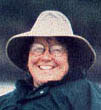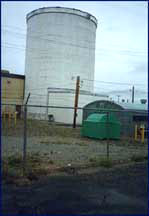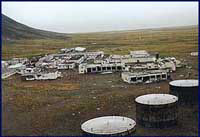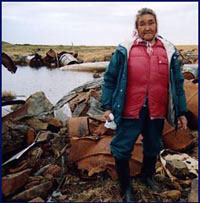Pamela K. Miller is a biologist and director of Alaska Community Action on Toxics (ACAT). ACAT works to protect human health, water and air quality, and the natural environment by collaborating with affected communities under right-to-know and other laws. ACAT exposes polluters, seeks to hold them accountable, and offers technical assistance to citizens who want to eliminate contaminants from their environment.

Tuesday, 30 May 2000
ANCHORAGE, Alaska
At just past midnight, the sun is setting over Mount Susitna across Cook Inlet. I’m at the office preparing for a briefing today on the environmental and health effects of persistent pollutants in Alaska for officials from the Interior Department and Congress. Marilyn Heiman, Bruce Babbitt’s special assistant for Alaska, invited me to talk about the importance of the global treaty to reduce and eliminate certain toxic chemicals. For us, this is not an abstract issue, but one that affects the safety of our water and food, our health and the health of our children. The problem is how to say everything that needs to be said in five minutes.
I’m glad for the long daylight hours, but like other Alaskans, I tend to turn manic in the summer. From the office, I can see that fishermen are still plying the waters of Ship Creek near the Port of Anchorage. I wonder if they know about the three Superfund sites just upstream at Fort Richardson, Elmendorf Air Force Base, and the Standard Steel industrial site. How could this be Alaska? Unfortunately, the military, mining companies, and oil corporations continue to pollute with impunity here. ACAT has used GIS mapping to locate over 2,000 contaminated sites around the state. Most people tend to think of Alaska as pristine. It’s my job to break the bad news (it’s our right to know!) and get people to do something about it (let’s find creative ways to eliminate toxic chemicals before they are produced and released in a huge uncontrolled experiment!).
Another staff person, Lorraine Eckstein, is here completing a lengthy article about ACAT’s work for the Alaska Conservation Foundation Dispatch. It’s good to have some company, but we’re both running out of steam after working on it for several hours. I try to remember that the article will go out to some 15,000 people and help inform them about important contamination issues in Alaska and the significance of our work.

A decommissioned nuclear reactor at Fort Greely.
Photo: ACAT.
It has been a busy weekend with putting the finishing touches on our investigative report about the deliberate radioactive-waste dumping by the U.S. Army at Fort Greely in Interior Alaska. I made two trips to the printer to proofread the report and then dropped the final copy off for our volunteer webmaster.
People in the small community of Delta, about 80 miles from Fairbanks, asked if we would investigate the safety of the experimental nuclear reactor at Fort Greely. This report represents two years of research by our organization working with Norm Buske of Nuclear Weapons Free America. Norm is a wacky physicist who investigates the transgressions of the Department of Energy and Department of Defense at places like Hanford, the Navy nuclear submarine base at Bremerton, Wash., and the French nuclear test site in the Pacific. Norm and I authored a report on the radioactive leakage from the world’s largest underground nuclear test site at Amchitka Island, Alaska.
We are preparing for the release of this report on Fort Greely by printing several hundred copies and making it available on our web site on June 6. Stay tuned for the revelations!
“Knowing what I do, there would be no future peace for me if I kept silent.”
— Rachel Carson
Wednesday, 31 May 2000
ANCHORAGE, Alaska
I seem to be keeping some crazy hours this week — early mornings and late nights. This morning I was on the phone at 6 a.m. (Alaska time is four hours earlier than east coast time) talking with state and federal agency people in Washington, D.C., about the impacts of the former military base at Northeast Cape on Alaska’s Saint Lawrence Island. I made a large pot of tea to awaken myself enough participate intelligently (I hope) in the conversation.

Toxic waste on Saint Lawrence Island.
Photo: ACAT.
The agencies are finally taking notice of the concerns of Saint Lawrence Island people about the toxic waste site created by the United States military. I think it is difficult for people inside the beltway to imagine what life is like on an island in the northern Bering Sea near the Chukotka Peninsula of Siberia, where the Yu’pik people depend almost entirely on the sea and the land for their sustenance — fish, greens, berries, seals, walrus, whales, reindeer.
Members of the Alaska Native community of Savoonga are concerned about the high number of people with cancers and other health problems, especially among those who use the Northeast Cape area for subsistence. They asked for our assistance in getting the military to clean up the toxic mess. The military dumped massive amounts of fuels (at least 220,000 gallons), PCBs, solvents, heavy metals, and other contaminants there. The Department of Defense considered Saint Lawrence Island a very significant strategic location during the Cold War because it is so close to Russia.

Annie Alowa in front of the military’s mess.
Photo: ACAT.
Annie Alowa, a community health aide and elder from Savoonga, called on us and we worked together to catalyze some action. Annie herself contracted cancer and asked me to interview her just before she died. The video we produced, I Will Fight Until I Melt, has been distributed widely to EPA officials, Pentagon officials, media folks, Congress, and many people who request it. I remember her words everyday — just two weeks before she died, she told me, “Keep it up, Miller.”
Sterling Gologergen, also from Savoonga on Saint Lawrence Island, has worked here for about a month in a staff position with both Alaska Community Action on Toxics and Indigenous Environmental Network. She is working with tribes in Alaska to get national and international attention focused on the problem of persistent pollutants — to make sure that Alaska Native people have a voice in eliminating the sources of contaminants that affect our environment and health here in the north.
The United Nations is facilitating negotiations involving 120 nations to develop a legally binding treaty to phase out some of the worst persistent organic pollutants (POPs), chemicals such as DDT and other pesticides, PCBs, dioxins. These chemicals are transported northward by wind and ocean currents and trapped in the cold environment. POPs tend to accumulate in the fatty tissues of fish, seals, polar bears, and humans. The Arctic has become a hemispheric sink for many of these toxic chemicals.
People in Alaska and around the world have an historic opportunity to encourage the United States to enact and ratify a strong treaty that could eliminate major sources of toxic chemicals that affect our health. The U.S. position has been weak thus far. We are working to remind the State Department, the lead negotiator for the U.S., that this is a crucia
l issue for us, one that has real effects on our health and the health of our environment. We have a lot of work to do!
Thursday, 1 Jun 2000
ANCHORAGE, Alaska
Yesterday I took part in a walk and edible greens gathering expedition with our staff and volunteers along the bluffs above Cook Inlet. We spent several hours there searching for and picking greens. Sterling gathered fireweed tips. Felix specialized in gathering bluebell flowers and nettles. Lydia picked fireweed tips and yarrow. I picked nettles — just the new growth at the top three to four inches of each plant. I have several “secret” and prolific nettle patches that I go back to each spring. Geran, our resident botanical expert, and her dog Arlo kept us all working hard out there. I think we all needed a break from the office and a celebration of spring in Alaska!
Here’s my special recipe for nettles: Gather the nettles using garden gloves (nettles sting, but the steaming takes the “sting” out), pick only the young leaves and stems (the tops regenerate), steam them lightly in a vegetable steamer (about a minute after the water in the bottom of the pan boils), saute the nettles in olive oil with lots of garlic, then serve hot with a dash of fresh lemon juice. They are delicious and nutritious! I crave nettles in spring so I go out to pick them two to three times a week during the early morning and eat ’em up for breakfast.
We gathered the wild greens in preparation for our commemoration of Rachel Carson’s birthday Wednesday evening. The event featured organic and wild edible foods, readings by community members, and an organic gardening workshop. Over 100 people came to this event sponsored by both ACAT and the Alaska Women’s Environmental Network. It was a great event because we had an opportunity to combine activist work (advocating for organic foods and protecting Alaska Native subsistence foods) with hands-on learning about organic gardening, and readings of Rachel Carson’s inspiring books! It was wonderful to see some of the high school students from Alaska Youth for Environmental Action there — they worked very closely with ACAT in getting the Anchorage School District to pass a “least toxic” pest management plan. Our motto: “Children First, Pesticides Last!”
The phone in the office rang constantly yesterday. I had a stack of messages that seemed to keep growing faster than I could keep up. Many of our calls concern immediate life and death issues. Calls received: A woman called ACAT from a western Alaska village where raw sewage is getting dumped into the sea from an improperly installed system designed by the federal Indian Health Service. A man who is concerned about what he perceives as a cluster of brain cancers near the petrochemical facilities on the Kenai Peninsula called ACAT to ask for assistance in organizing community-based health surveys and raising attention among the agencies. I spoke with a tribal environmental coordinator to develop strategies for getting the military to clean up a nasty toxic waste site at Cape Romanzof near the villages of Scammon Bay, Hooper Bay, Paimute, and Chevak.
Friday, 2 Jun 2000
ANCHORAGE, Alaska
Began today by working in the garden outside the ACAT office. We are trying to create a small demonstration organic garden here. Lots of people walk by because we are downtown and near the coastal trail. So far, I’ve planted peas, lettuces, spinach, cilantro and other herbs, and flowers — forget-me-nots, shooting stars, lupine, iris. Very satisfying. The crab-apple tree and mountain ash are in full bloom.
We’re getting ready for the release of our investigative report on Fort Greely, a place where the Department of Defense operated a nuclear power plant during the ’60s and ’70s. We suspect that the purpose of the reactor was more than just power generation. Tuesday, June 6 is the day. I’m making a few press calls to key reporters today. Preparing the press release for review by the coauthors of the report. Sending advance copies out to people who helped us out along the way and who have a direct connection with what has happened there.
I’m trying not to panic when I look at all of the work that needs to be done. We’re late on getting a newsletter out. Finding some quiet time for writing seems to be one of the greatest challenges of working in a busy nonprofit office. Foundation proposal due dates looming — relentless. Lots of research and strategy development needed on virtually all of our campaigns — water quality, POPs (persistent organic pollutants), military toxics, pesticide right-to-know. We’ve been hampered by a failing computer, a broken fax, and a broken copier — Liz and I are just getting these cantankerous machines back on line. Travis from Online Networking for the Environment (ONE/Northwest) has been in here sorting out our Internet access difficulties — what a marvel! We’re having some growing pains as we transition from one full-time staff person to four — we don’t yet have the necessary computers and office space to support everyone.
I am thankful for the people I work with, such smart and thoroughly dedicated people. Such a privilege to work with Sterling, Lydia, Liz, and Geran. Our new intern, Felicien Poncelet, is an Alaska Pacific University student in biology from France. He has good GIS skills and is using his time with us this summer investigating the military Superfund sites in Alaska. We have a small grant from the EPA Environmental Justice Program to synthesize information and prepare maps showing downstream impacts and potential exposure pathways. We’re planning community meetings and some field investigations this summer. A canoe trip along the Chena River will provide an opportunity to look at downstream impacts from Fort Wainwright.
Arlo is calling me. He is Geran’s dog and I’m on walking duty this afternoon while she is at a workshop. Walking with Arlo will give me a new perspective on life, so out we go!
It has been fun to write this daily journal during the past week. Please drop me an email message at pkmiller@akaction.net.

